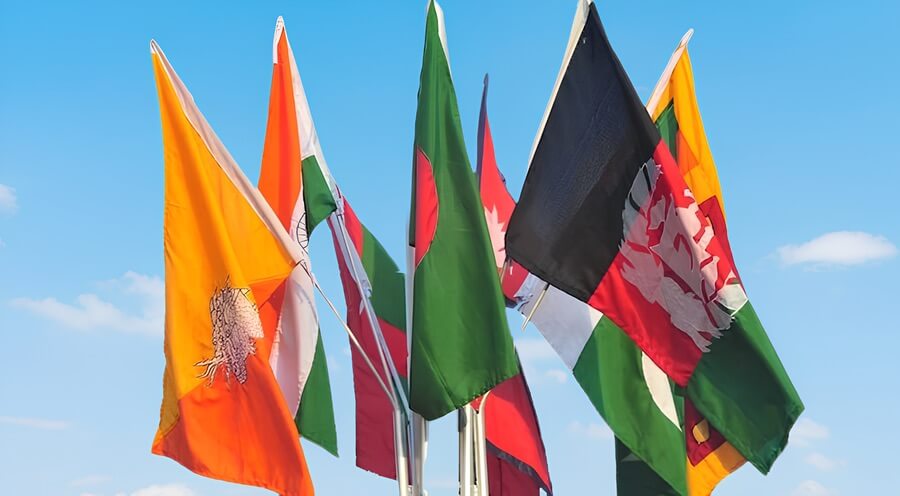By Sarina Tareen
SAARC stands to struggle again under the weight of political deadlock and mutual mistrust, caught in the cross-border hostility between India- Pakistan.

The question that looms large is: does SAARC still matter today? The South Asian Association for Regional Cooperation (SAARC) has struggled to remain relevant. Continuous intra-regional conflicts, and especially the India-Pakistan rivalry centered on Kashmir, have paralyzed collaboration and dialogue.
These bilateral tensions have stalled SAARC’s ability to foster meaningful collaboration. Historical grievances, political mistrust, and conflicting national priorities further destabilize regional cohesion, with states often highlighting bilateral concerns over collective progress.
A widely used theory in the international relations domain to explain the irrelevance of SAARC is “Neorealism”, where states are rational primary actors driven by national interest. India’s regional dominance creates a perception of hegemony. This results in self-help behaviors rather than mutual collaboration.
Critics argued that SAARC has proven to be very ineffective and remains the only platform that brings together all South Asian states. Nobel Prize Winner Dr. Muhammad Yunus and other regional thinkers and experts proposed ways to reform the region by following multi-speed integration, neutral venues for meetings, virtual summits, and setting up independent peace committees.
By engaging in these activities, SAARC may again become an important platform for managing South Asian issues like climate change, health, migration, and poverty alleviation. These challenges cannot be effectively addressed by military forums like QUAD and AUKUS. Where there is a risk of India becoming a customer in the growing arms economy, further eroding
Additionally, the rising threat of cross-border extremism and economic deviation, safety issues complicating trade, boosting regional connections, and dealing with global warming. Lack of operational application from SAARC due to its fragile structure. That struggles to enforce decisions or carry out initiatives effectively.
The cancellation of the 19th SAARC summit in 2016 to be held in Islamabad, Pakistan, clearly proved the fragility of the platform. AK Abdul Momen, who served as Minister of Foreign Affairs in Bangladesh, considers India-Pakistan hostility to be the main factor affecting the growth of SAARC.
The recent India-Pakistan conflict, as a result of the Pahalgam attack and India’s “Operation Sindoor” has once again stopped regional cooperation.There are allegations that the Indian paramilitary forces encouraged the spread of conspiracy theories, as has happened previously, for example in the Pulwama case in 2019. Critics argue that these events served Indian domestic political purposes, particularly during election periods, to influence public opinion through the mainstream media.
Pakistan remains open to dialogue with India, even on terrorism, but it insists that Kashmir should be a key issue in any negotiation. Meanwhile, India shifts the focus to contracted matters, like anti-terrorism and water. India has been criticized by Pakistan for using unjustified delays to damage the peace process. According to Pakistan, six SAARC summits have not been held due to India’s refusal to join. India was in favor of a “SAARC without Pakistan,” meaning multiregional ties in South Asia without Pakistan.
Also, increasing militancy and cross-border terrorism have weakened the security of the region. As a consequence of this situation, building cooperation on climate change, trade, and transport becomes more challenging. As a result, the organizational framework of SAARC remains weak. For example, after 42 months of prolonged delay, the 11th SAARC summit, scheduled for November 1999, finally took place in January 2002. Similarly, in 2014, the 18th summit, postponed for three years, finally proceeded.
Preferring the Bay of Bengal Initiative for Multi-Sectoral Technical and Economic Cooperation (BIMSTEC), over SAARC, indicates that India is trying to bypass Pakistan from regional cooperation. However, this approach has limitations. Regional actors such as Nepal, Bangladesh, and Sri Lanka, consider it inappropriate for any organization, that does not include Pakistan as member, to have legitimate authority over South Asia. Omitting Pakistan restricts the potential of BIMSTEC for addressing conflict and enhancing trust-building measures.
Given these challenges, using SAARC as a platform for informal talks is potentially practical. SAARC does not aim to directly end conflicts, but it has given ample space to symbolic events such as the handshake between Vajpayee and Musharraf in 2004 after the Kargil War.
In 2014, Prime Minister Narendra Modi presented India’s neighborhood first policy, to drive cooperative efforts based on mutual trust among South Asian countries. However, the political shift in 2014, in Bangladesh, Nepal, Maldives, and Sri Lanka has placed this policy effectiveness under great pressure. In this context, it refers to India not maintaining its power in the region with force but with dominance of ideas and beliefs. India intends to assert its military and economic dominance in the region. But this approach has alienated smaller regional neighbors and pushed them toward alternative alliances, particularly with China.
Beijing’s position remains embedded in its “Iron Brotherhood” with Pakistan, strengthened by continued solidarity and military cooperation, including intelligence sharing and logistical support in the Gilgit-Baltistan region. Beijing’s support is practical and rooted in its larger Belt and Road Initiative BRI, and the China-Pakistan Economic Corridor CPEC, considered a key to its success. Any instability in South Asia poses a danger to China’s plans for infrastructure and energy. To balance India’s regional hegemony in South Asia, and uphold its economic interest, Beijing also supports Pakistan diplomatically in international forums, like the UN.
India’s strong relations with Bangladesh deteriorated quickly once Sheikh Hasina lost power in 2024, after widespread student protests. India’s action triggered nationalist backlash and heightened anti-Indian sentiments in Bangladesh, due its stance on minority rights and refusal to expel Sheikh Hasina for trial. These complications not only impact bilateral cooperation but also threaten regional security. A precarious situation in Bangladesh might drive insurgent’s groups to penetrate in the Northeast region of India.
The regional dynamics continue to reflect the escalating frustration with India’s coercive diplomacy. The campaign, “India Out”, was led by Maldivian former president Mohammad Muizzu. along with ongoing hostility in Nepal over blockade and border issues, this reveals the failure of India’s coercive diplomacy.
As noted by Henry Kissinger, the power dynamics in South Asia risk alienation. In this context, India needs to adjust its coercive diplomacy. SAARC could once again guide the region towards greater unity and collaboration.
Author: Sarina Tareen – Research Intern at Balochistan Think Tank Network (BTTN), International Relations graduate from BUITEMS, Quetta, Pakistan.
(The views expressed in this article belong only to the author and do not necessarily reflect the editorial policy or views of World Geostrategic Insights).







